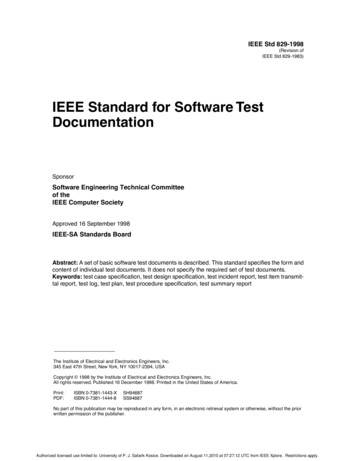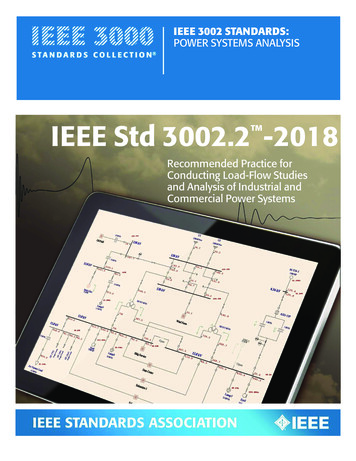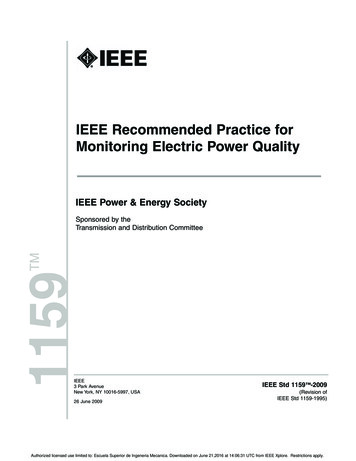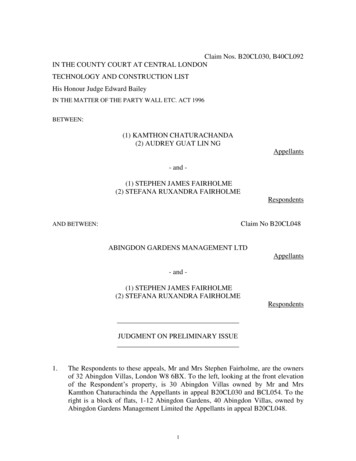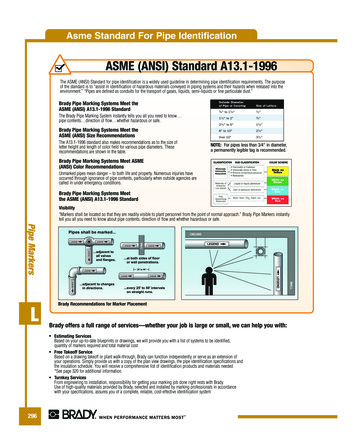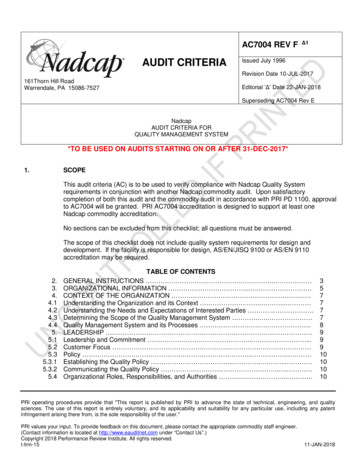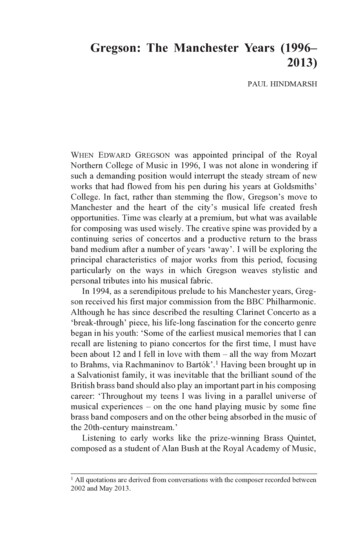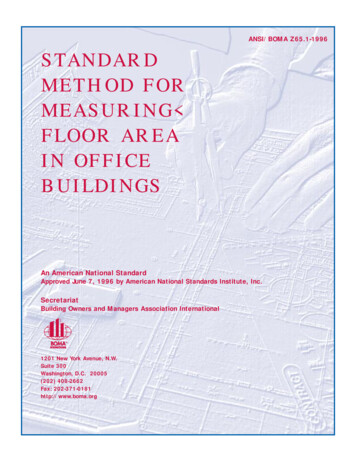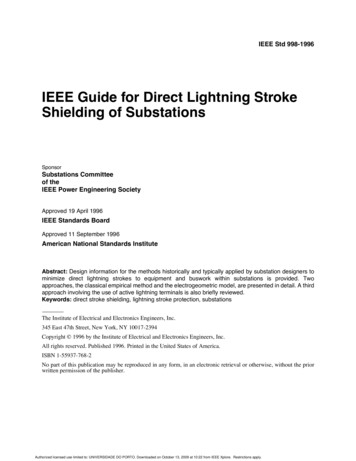
Transcription
IEEE Std 998-1996IEEE Guide for Direct Lightning StrokeShielding of SubstationsSponsorSubstations Committeeof theIEEE Power Engineering SocietyApproved 19 April 1996IEEE Standards BoardApproved 11 September 1996American National Standards InstituteAbstract: Design information for the methods historically and typically applied by substation designers tominimize direct lightning strokes to equipment and buswork within substations is provided. Twoapproaches, the classical empirical method and the electrogeometric model, are presented in detail. A thirdapproach involving the use of active lightning terminals is also briefly reviewed.Keywords: direct stroke shielding, lightning stroke protection, substationsThe Institute of Electrical and Electronics Engineers, Inc.345 East 47th Street, New York, NY 10017-2394Copyright 1996 by the Institute of Electrical and Electronics Engineers, Inc.All rights reserved. Published 1996. Printed in the United States of America.ISBN 1-55937-768-2No part of this publication may be reproduced in any form, in an electronic retrieval or otherwise, without the priorwritten permission of the publisher.Authorized licensed use limited to: UNIVERSIDADE DO PORTO. Downloaded on October 13, 2009 at 10:22 from IEEE Xplore. Restrictions apply.
IEEE Standards documents are developed within the IEEE Societies and the Standards Coordinating Committees ofthe IEEE Standards Board. Members of the committees serve voluntarily and without compensation. They are notnecessarily members of the Institute. The standards developed within IEEE represent a consensus of the broadexpertise on the subject within the Institute as well as those activities outside of IEEE that have expressed an interestin participating in the development of the standard.Use of an IEEE Standard is wholly voluntary. The existence of an IEEE Standard does not imply that there are no otherways to produce, test, measure, purchase, market, or provide other goods and services related to the scope of the IEEEStandard. Furthermore, the viewpoint expressed at the time a standard is approved and issued is subject to changebrought about through developments in the state of the art and comments received from users of the standard. EveryIEEE Standard is subjected to review at least every Þve years for revision or reafÞrmation. When a document is morethan Þve years old and has not been reafÞrmed, it is reasonable to conclude that its contents, although still of somevalue, do not wholly reßect the present state of the art. Users are cautioned to check to determine that they have thelatest edition of any IEEE Standard.Comments for revision of IEEE Standards are welcome from any interested party, regardless of membership afÞliationwith IEEE. Suggestions for changes in documents should be in the form of a proposed change of text, together withappropriate supporting comments.Interpretations: Occasionally questions may arise regarding the meaning of portions of standards as they relate tospeciÞc applications. When the need for interpretations is brought to the attention of IEEE, the Institute will initiateaction to prepare appropriate responses. Since IEEE Standards represent a consensus of all concerned interests, it isimportant to ensure that any interpretation has also received the concurrence of a balance of interests. For this reason,IEEE and the members of its societies and Standards Coordinating Committees are not able to provide an instantresponse to interpretation requests except in those cases where the matter has previously received formalconsideration.Comments on standards and requests for interpretations should be addressed to:Secretary, IEEE Standards Board445 Hoes LaneP.O. Box 1331Piscataway, NJ 08855-1331USANOTE Ñ Attention is called to the possibility that implementation of this standard may require use of subject matter coveredby patent rights. By publication of this standard, no position is taken with respect to the existence or validity of anypatent rights in connection therewith. The IEEE shall not be responsible for identifying all patents for which alicense may be required by an IEEE standard or for conducting inquiries into the legal validity or scope of thosepatents that are brought to its attention,Authorization to photocopy portions of any individual standard for internal or personal use is granted by the Instituteof Electrical and Electronics Engineers, Inc., provided that the appropriate fee is paid to Copyright Clearance Center.To arrange for payment of licensing fee, please contact Copyright Clearance Center, Customer Service, 222 RosewoodDrive, Danvers, MA 01923 USA; (508) 750-8400. Permission to photocopy portions of any individual standard foreducational classroom use can also be obtained through the Copyright Clearance Center.Authorized licensed use limited to: UNIVERSIDADE DO PORTO. Downloaded on October 13, 2009 at 10:22 from IEEE Xplore. Restrictions apply.
Introduction[This introduction is not part of IEEE Std 998-1996, IEEE Guide for Direct Lightning Stroke Shielding of Substations (ANSI).]This guide was prepared by the Direct Stroke Shielding of Substations Working Group of the Substations Committee,Transmission Substations Subcommittee. Work on this guide began in 1973 and many former members madecontributions towards its completion. The membership of the working group during the preparation of this draft was asfollows:R. J. Wehling, ChairNelson Barbeito, Vice ChairJohn R. Clayton, SecretaryHanna E. AbdallahP. ChowdhuriSteve L. DuongDennis R. FalkenheimGeorge FlaigDave L. GoetzWilliam A. GriegoRichard J. HellwegAbdul M. MousaRobert S. NowellJ. Ted OrrellJan PanekR. J. PerinaDon RogersPankaj K. SenFrank C. ShainauskasW. Keith SwitzerEdgar R. TaylorAung ThaikFormer working group members who made signiÞcant contributions towards development of the guide were asfollows:Gary D. BehrensIvan B. ClevengerGeorge W. CrouchWilliam H. DainwoodFrank J. JaskowiakA. P. (Paul) JohnsonZlatko KapelinaFrank F. KlugeiiiAuthorized licensed use limited to: UNIVERSIDADE DO PORTO. Downloaded on October 13, 2009 at 10:22 from IEEE Xplore. Restrictions apply.
The following persons were on the balloting committee:William J. AckermanS. J. ArnotA. C. BakerNelson BarbeitoG.J. BartokBurhan BecerKevin M. BevinsMichael J. BioKenneth L. BlackCharles BlattnerW.R. BlockSteven A. BoggsPhilip C. BolinSteven D. BrownJames C. BurkeJohn B. CannonDaniel CharbonnetFrank Y. ChuD.Mason ClarkJ. R. ClaytonRobert CorlewRichard CottrellEugene F. CounselWilliam DailyFrank A. DenbrockClifford C. DiemondW. Bruce DietzmanTerry DoernClaude DurandGary R. EngmannJames W. EvansRon J. FarquharsonLenard N. FergusonDavid Lane GarrettFloyd W. GreenwayJohn GrzanDavid L. HarrisR.J. HellwegJohn E. HolladayMike L. HolmKenneth JacksonZlatko KapelinaRichard P. KeilAlan E. KollarT. L. KrummreyLuther W. KurtzDonald N. LairdLawrence M. LaskowskiAlfred A. LeiboldC.T. LindebergH. Peter LipsRusko MatulicJohn D. McDonaldThomas S. McLenahanA. P. Sakis MeliopoulosAbdul M. MousaPhilip R. NanneryR. S. NowellEdward V. OlavarriaJ. Ted OrrellJames S. OswaldShashi G. PatelRaymond J. PerinaK. PetterssonWalter PrystajeckyJ. F. QuinataB. Don RussellJakob SabathSamuel C. SciaccaF. C. ShainauskasJune SingletaryLee H. SmithRobert C. SodergrenBodo SojkaRobert C. St. ClairRobert P. StewartW. Keith SwitzerStanley R. SykesJohn T. TengdinHemchand ThakarCharles F. ToddDuane R. TorgersonL. F. VolfR. J. WehlingW. M. WernerBahman Yamin-AfsharivAuthorized licensed use limited to: UNIVERSIDADE DO PORTO. Downloaded on October 13, 2009 at 10:22 from IEEE Xplore. Restrictions apply.
The Þnal conditions for approval of this standard were met on 19 April 1996. This standard was conditionally approvedby the IEEE Standards Board on 14 March 1996, with the following membership:Donald C. Loughry, ChairRichard J. Holleman, Vice ChairAndrew G. Salem, SecretaryGilles A. BarilClyde R. CampJoseph A. CannatelliStephen L. DiamondHarold E. EpsteinDonald C. FleckensteinJay Forster*Donald N. HeirmanBen C. JohnsonE. G. ÒAlÓ KienerJoseph L. Koepfinger*Stephen R. LambertLawrence V. McCallL. Bruce McClungMarco W. MigliaroMary Lou PadgettJohn W. PopeJose R. RamosArthur K. ReillyRonald H. ReimerGary S. RobinsonIngo RŸschJohn S. RyanChee Kiow TanLeonard L. TrippHoward L. Wolfman*Member EmeritusAlso included are the following nonvoting IEEE Standards Board liaisons:Satish K. AggarwalAlan H. CooksonChester C. TaylorKristin M. DittmannIEEE Standards Project EditorvAuthorized licensed use limited to: UNIVERSIDADE DO PORTO. Downloaded on October 13, 2009 at 10:22 from IEEE Xplore. Restrictions apply.
CLAUSE1.PAGEOverview .11.1 Scope . 11.2 Purpose. 11.3 Definitions. 22.Lightning stroke phenomena.32.12.22.32.42.52.62.7Charge formation in clouds. 3Stroke formation . 4Strike distance . 5Stroke current magnitude . 8Keraunic level . 9Ground flash density . 9Lightning detection networks. 113.The design problem.124.Empirical design methods .134.1 Fixed angles . 144.2 Origin of empirical curves . 154.3 Application of empirical curves . 185.The electrogeometric model (EGM) .215.15.25.35.45.5History. 21A revised EGM . 23Application of the EGM4 by the rolling sphere method. 31Application of revised EGM by Mousa and Srivastava method. 39Calculation of failure probability . 426.Active lightning terminals.427.Bibliography.43Annex A (Informative) Empirical shielding curves.49Annex B (Informative) Sample calculations .53Annex C (Informative) Calculation of corona radius and surge impedance under corona .125Annex D (Informative) Calculation of failure probability .128Annex E (Informative) IEEE questionnaireÑ1991 .130Annex F (Informative) The Dainwood method .147Annex G (Informative) Direct lightning stroke protection .148viAuthorized licensed use limited to: UNIVERSIDADE DO PORTO. Downloaded on October 13, 2009 at 10:22 from IEEE Xplore. Restrictions apply.
IEEE Guide for Direct Lightning StrokeShielding of Substations1. Overview1.1 ScopeThe scope of this guide is the identiÞcation and discussion of design procedures to provide direct stroke shielding ofoutdoor distribution, transmission, and generating plant substati
IEEE Standard is subjected to review at least every Þve years for revision or reafÞrmation. When a document is more than Þve years old and has not been reafÞrmed, it is reasonable to conclude that its contents, although still of some value, do not wholly reßect the present state of the art. Users are cautioned to check to determine that they have the latest edition of any IEEE Standard .


